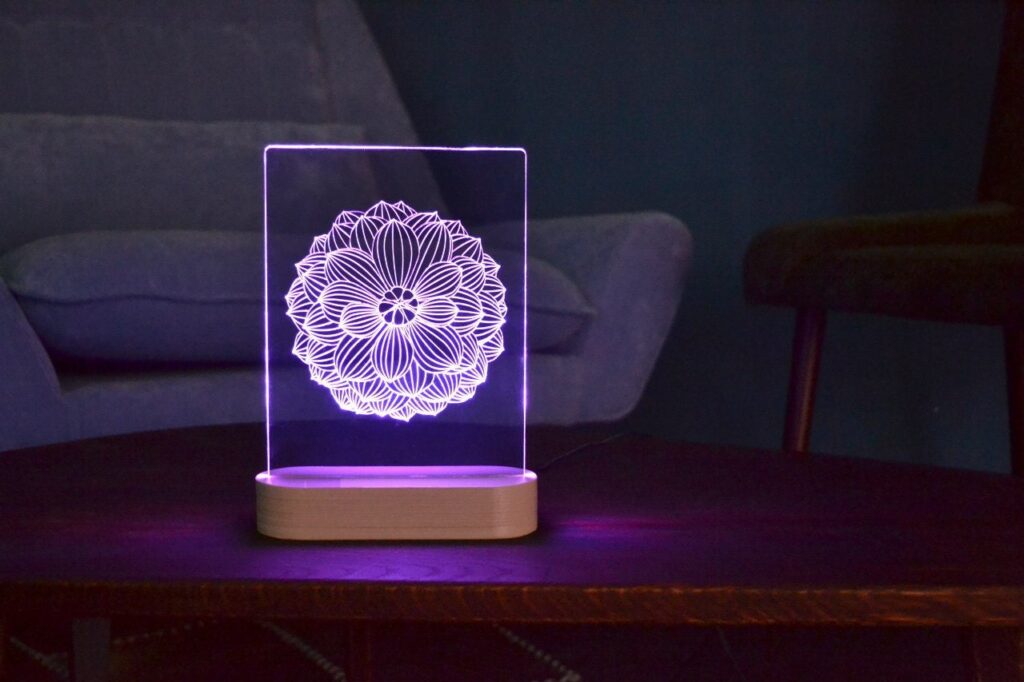
Acrylic Light: Illuminating Spaces with Modern Design and Efficiency
In the realm of modern lighting solutions, acrylic light fixtures have emerged as a prominent choice for both residential and commercial spaces. Combining aesthetic appeal with functional brilliance, acrylic light offers a versatile and energy-efficient way to illuminate interiors and exteriors. This article delves into the various aspects of acrylic light, exploring its benefits, applications, design considerations, and the factors that contribute to its growing popularity.
What is Acrylic Light?
Acrylic light, in its simplest form, refers to lighting fixtures that incorporate acrylic materials as a primary component. Acrylic, also known as polymethyl methacrylate (PMMA), is a transparent thermoplastic often used as a lightweight and shatter-resistant alternative to glass. In lighting, acrylic can be used for diffusers, lenses, housings, and decorative elements. It’s valued for its ability to transmit light efficiently while also providing design flexibility.
Benefits of Using Acrylic Light
- Durability: Acrylic is significantly more impact-resistant than glass, making acrylic light fixtures less prone to breakage and ideal for high-traffic areas.
- Lightweight: The lightweight nature of acrylic simplifies installation and reduces the structural support required for mounting acrylic light fixtures.
- Design Flexibility: Acrylic can be molded into various shapes and sizes, offering designers a wide range of creative possibilities. This allows for the creation of unique and visually appealing acrylic light designs.
- Energy Efficiency: When paired with LED technology, acrylic light fixtures offer excellent energy efficiency. LEDs consume less power and have a longer lifespan compared to traditional incandescent bulbs.
- Optical Clarity: Acrylic provides excellent light transmission, ensuring bright and even illumination. It can also be formulated to diffuse light, reducing glare and creating a softer, more comfortable ambiance.
- UV Resistance: Many acrylic formulations are UV-resistant, making acrylic light suitable for outdoor applications where exposure to sunlight is a concern.
Applications of Acrylic Light
Residential Lighting
In homes, acrylic light fixtures are used in a variety of applications, including:
- Ceiling Lights: Flush-mount and semi-flush-mount acrylic light fixtures provide general illumination for living rooms, bedrooms, and hallways.
- Pendant Lights: Acrylic light pendants add a decorative touch and focused illumination to dining areas and kitchen islands.
- Wall Sconces: Acrylic light wall sconces offer accent lighting and can be used to highlight architectural features or artwork.
- Table and Floor Lamps: Acrylic light lamps provide task lighting for reading and other activities.
- Bathroom Lighting: Water-resistant acrylic light fixtures are ideal for bathrooms, providing bright and safe illumination.
Commercial Lighting
In commercial settings, acrylic light is used to create a welcoming and productive environment. Common applications include:
- Office Lighting: Acrylic light troffers and linear fixtures provide uniform illumination for offices, reducing eye strain and improving productivity.
- Retail Lighting: Acrylic light spotlights and track lighting highlight merchandise and create an attractive shopping experience.
- Hospitality Lighting: Acrylic light fixtures in hotels, restaurants, and bars create a warm and inviting atmosphere.
- Educational Facilities: Durable and energy-efficient acrylic light fixtures are used in classrooms, libraries, and other educational spaces.
- Industrial Lighting: High-bay acrylic light fixtures provide bright illumination for warehouses, factories, and other industrial facilities.
Outdoor Lighting
Outdoor acrylic light fixtures enhance safety and security while also adding aesthetic appeal to outdoor spaces. Common applications include:
- Pathway Lighting: Acrylic light bollards and path lights illuminate walkways and driveways, improving visibility and safety.
- Porch and Patio Lighting: Acrylic light fixtures provide ambient lighting for outdoor living spaces.
- Security Lighting: Motion-activated acrylic light fixtures deter intruders and enhance security.
- Landscape Lighting: Acrylic light spotlights and floodlights highlight trees, shrubs, and other landscape features.
Design Considerations for Acrylic Light
When selecting acrylic light fixtures, several design considerations should be taken into account:
- Style: Choose acrylic light fixtures that complement the overall style of the space. Options range from modern and minimalist to traditional and ornate.
- Size: Select acrylic light fixtures that are appropriately sized for the space. Overly large fixtures can overwhelm a small room, while undersized fixtures may not provide adequate illumination.
- Color Temperature: Consider the color temperature of the light emitted by the acrylic light fixture. Warm white light (2700K-3000K) creates a cozy and inviting atmosphere, while cool white light (4000K-5000K) provides brighter and more focused illumination.
- Brightness: Choose acrylic light fixtures with the appropriate brightness for the intended application. Brightness is measured in lumens, with higher lumen values indicating brighter light.
- Dimming Capability: Consider acrylic light fixtures with dimming capability to adjust the light level to suit different activities and moods.
- Energy Efficiency: Opt for acrylic light fixtures that are energy-efficient. Look for fixtures with high energy star ratings.
The Future of Acrylic Light
The future of acrylic light looks promising, with ongoing advancements in materials, designs, and technologies. Expect to see:
- Smarter Lighting: Integration of smart home technology, allowing for remote control and automation of acrylic light fixtures.
- More Sustainable Materials: Development of bio-based and recycled acrylic materials, reducing the environmental impact of acrylic light production.
- Advanced LED Technology: Further improvements in LED efficiency and color rendering, enhancing the performance of acrylic light fixtures.
- Customizable Designs: Increased use of 3D printing and other advanced manufacturing techniques to create highly customized acrylic light designs.
Conclusion
Acrylic light has established itself as a versatile and innovative lighting solution, offering a combination of aesthetic appeal, durability, and energy efficiency. Whether used in residential, commercial, or outdoor settings, acrylic light fixtures provide bright, even illumination while also enhancing the overall design of the space. As technology continues to advance, acrylic light is poised to play an even greater role in shaping the future of lighting. [See also: LED Lighting Solutions] [See also: Modern Home Lighting Ideas]
